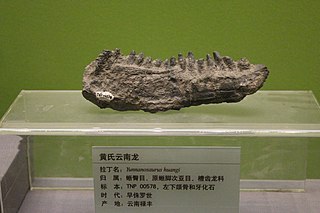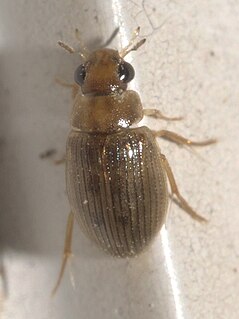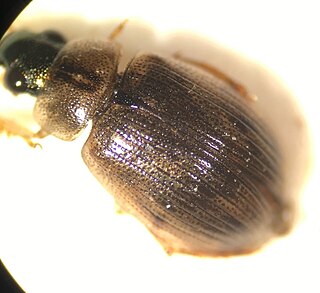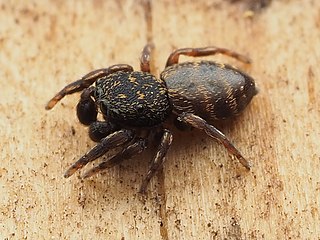
Mamenchisaurus is a genus of sauropod dinosaur known for their remarkably long necks which made up nearly half the total body length. Numerous species have been assigned to the genus; however, many of these might be questionable. Fossils have been found in the Sichuan Basin and Yunnan Province in China. Several species are from the Upper Shaximiao Formation whose geologic age is uncertain. However, evidence suggests that this be no earlier than the Oxfordian stage of the Late Jurassic. M. sinocanadorum dates to the Oxfordian stage and M. anyuensis to the Aptian stage of the Early Cretaceous ~114.4 mya. Most species were medium to large size sauropods 15 to 26 meters in length. Two as yet undescribed cervical vertebrae, which might belong to M. sinocanadorum, suggest one of the largest dinosaurs known; estimated at 35 metres (115 ft) in length and possibly weighed 60 and 80 tonnes.

The white-winged vampire bat, a species of vampire bat, is the only member of the genus Diaemus. They are found from Mexico to northern Argentina and are present on the islands of Trinidad and Margarita.
Yimenosaurus is an extinct genus of plateosaurid sauropodomorph dinosaur that lived in China in the Early Jurassic. The genus was first named in 1990 by Ziqi Bai, Jie Yang and Guohui Wang, along with its type and only species, Yimenosaurus youngi. The species name honours renowned Chinese paleontologist Yang Zhongjian, the father of Chinese paleontology, known as C.C. Young in English. Known material includes the holotype, an almost complete skull and mandible, as well as incomplete cervical and dorsal vertebrae, a mostly complete sacrum, an ilium, ischia, partial ribs and complete femur, and a paratype, a well-preserved postcrania with a fragmentary skull. In 2010 Paul estimated its length at 9 metres (30 ft) and its weight at 2 tonnes.

Yunnanosaurus is an extinct genus of sauropodomorph dinosaur that lived approximately 201 to 168 million years ago in what is now the Yunnan Province, in China, for which it was named. Yunnanosaurus was a large sized, moderately-built, ground-dwelling, quadrupedal herbivore, that could also walk bipedally, and ranged in size from 7 meters (23 feet) long and 2 m (6.5 ft) high to 4 m (13 ft) high in the largest species.

Bishanopliosaurus is a genus of plesiosaur. The type species is B. youngi, based on remains found in the Ziliujing Formation of China.

Berosus is a genus of beetles in the family Hydrophilidae, the water scavenger beetles. The genus contains 273 species. It is distributed worldwide.

Berosus exiguus is a species of water scavenger beetles found in the United States, the Bahamas, and Cuba. These beetles are small, ranging from 2.0 to 3.5 mm in length. They can be identified by their small size, yellowish-brown head, distinctly impressed elytral striae (stripes), and often faint spots on the elytra.
Berosus metalliceps is a species of hydrophilid beetles from the United States, Mexico, the Bahamas and Cuba.
Berosus corrini is a species of hydrophilid beetles native to the United States. It was originally described by David P. Wooldridge in 1964 and is characterized by the lack of striae on its elytra, larger size, two projections on its sternal emargination, and laterally-projecting dorsal edges on the parameres.

Berosus sayi is a species of hydrophilid beetles native to the United States. It is a synonym of Berosus striatus, which was originally described by Thomas Say in 1825, and females can be characterized by a small tooth on the suture near the apex of each elytron.
Hydroporus signatus is a species of predaceous diving beetle in the family Dytiscidae. It is found in North America.

Berosus fraternus is a species of water scavenger beetle in the family Hydrophilidae. It is found in North America.
Echmepteryx youngi is a species of scaly-winged barklouse in the family Lepidopsocidae. It is found in North America.
Berosus moerens is a species of water scavenger beetle in the family Hydrophilidae. It is found in Central America.
Berosus hatchi is a species of water scavenger beetle in the family Hydrophilidae. It is found in North America.

Attidops youngi is a species of jumping spider in the family Salticidae. It is found in the United States and Canada.

Phileurus is a genus of rhinoceros beetles in the family Scarabaeidae. There are more than 20 described species in Phileurus.
Berosus miles is a species of water scavenger beetle in the family Hydrophilidae. It is found in Central America and North America.
Peltotrupes youngi, known generally as Young's deepdigger scarab, is a species of earth-boring scarab beetle in the family Geotrupidae. Other common names include the ocala burrowing scarab and ocala deepdigger scarab beetle. It is found in North America.
Lü Junchang was a Chinese palaeontologist and professor at the Institute of Geology, Chinese Academy of Geological Sciences. An expert on Mesozoic reptiles, he described and named dozens of dinosaur and pterosaur taxa including Tongtianlong, Qianzhousaurus, Heyuannia, Gannansaurus, Yunnanosaurus youngi, and Darwinopterus.











